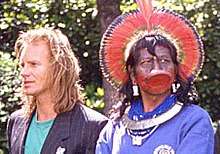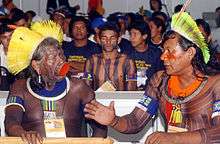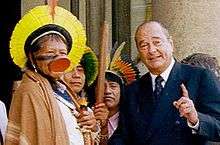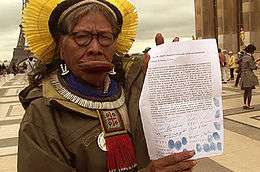Raoni Metuktire
Raoni Metuktire (born ca. 1930), also known as Chief Raoni or Ropni,[1] is an Indigenous Brazilian leader and environmentalist. He is a chief of the Kayapo people, a Brazilian Indigenous group from the plain lands of the Mato Grosso and Pará in Brazil, south of the Amazon River and along Xingu River and its tributaries. He is internationally famous as a living symbol of the fight for the preservation of the Amazon rainforest and indigenous culture.
Raoni Metuktire | |
|---|---|
.jpg) Chief Raoni Metuktire, 2013 | |
| Metuktire, Kayapo people leader | |
| Personal details | |
| Born | Circa 1930 Kapot, Mato Grosso, Brazil |
| Known for | Resistance to the Amazon Rainforest industrialization and deforestation |
| Nickname(s) | Raoni |
Early campaigns
Cacique (a Native American word for chieftain) Raoni Metuktire was born in the State of Mato Grosso in or around 1930, in the heart of the Brazilian part of the Amazon rainforest, in a village called Krajmopyjakare (today called Kapôt). Born in the Metuktire family of Kayapo people, he is one of Cacique Umoro’s sons. As the Kayapo tribe is nomadic, his childhood was marked by continuous travel, during which he witnessed many tribal wars. Guided by his brother Motibau, at the age of 15 he chose to have a painted wooden lip plate (called ‘botoque’ by the warriors of his tribe) placed under his lower lip.
Raoni and other members of the Metuktire tribe encountered the Western World for the first time in 1954. Initiated into the Portuguese language by Orlando Villas-Bôas, the eldest of the Villas-Bôas brothers and a famous indigenous anthropologist in Brazil, the young Raoni was ready for the Kuben’s invasion (Kuben meaning « the others », « white people »).
In 1964, he met King Leopold III of Belgium while the latter was on an expedition into indigenous reservations in Mato Grosso.
Deforestation was already a cause for concern when “Raoni”, a documentary film by Jean-Pierre Dutilleux and narrated by Jacques Perrin was shot. Marlon Brando, known for his support of Native American people, had just been paid an unprecedented $3.7 million for his 10-minute part in Superman, but agreed to appear for no salary in "Raoni's" opening sequence.
Brazilian media’s sudden interest made Raoni the banner-bearer of the fight for the preservation Amazon rainforest, which had been jeopardized by illegal deforestation, the increasing cultivation of soya beans, and the use of hydroelectric dams for the generation of electricity.
1989 international campaign

Raoni gained international attention thanks to musician Sting, who came to meet him in the Xingu in November 1987. On October 12, 1988, Sting participated with Raoni in a press conference prior to the Sao Paulo show of the ‘Human Rights Now!’ Amnesty International tour. After this event, Sting, his wife Trudie Styler, and Jean-Pierre Dutilleux founded the Rainforest Foundation. Its initial purpose was to support Raoni’s projects, the first being the demarcation of Kayapos territory threatened by invasion.
In February 1989, Raoni became one of the fiercest opponents to the Belo Monte Dam project. Television broadcasts transmitted his opinions in Altamira during a large assembly of chiefs.

Raoni visited 17 countries with Sting from April to June 1989. The very successful campaign gave him the opportunity to raise awareness around the world about the deforestation. Twelve rainforest foundations were created to raise funds for the establishment of a huge national park in the Rio Xingu River region, in Para and Mato Grosso Brazilian states. Raoni's dream was to unite the five demarcated indigenous territories (Baú, Kaiapó, Panará, Kapôt Jarina, Bàdjumkôre) with then undemarcated Mekragnotire lands. Along with the adjoining Xingu National Park, the united indigenous lands would cover approximately 180000 km² (nearly one-third the area of France).
In 1993, funds raised worldwide helped to make Raoni's dream a reality. The Xingu indigenous lands were reunited, creating one of the world's most important rainforest reserves.
International Ambassador for the preservation of the forest and Amazonian people's culture

French president Jacques Chirac declared Raoni a living symbol of the fight for the protection of the environment. Since 1989, the Kayapo leader has traveled to many places in the world, including the northeastern parts of Quebec, Canada, to visit the Innu people in August 2001; and to Japan in May 2007. His messages were particularly well received in European countries such as France, which he visited in 2000, 2001 and 2003.
Isolated from the rest of the world until the twentieth century, the indigenous peoples of the Xingu region have fought to orally preserve their traditions for countless generations. Raoni found ways to connect these cultures with the world, while keeping appropriate stoicism, distance and dignity. Although he meets with prominent people in many countries, he lives in a simple hut and owns nothing. The gifts he receives are always redistributed.
During his media appearances, he is almost always seen wearing a wreath of yellow feathers and arrayed with Kayapo earrings and necklaces. He is easily recognizable with his lip plate that stretches his lower lip. Subsequent generations have not kept this tradition; Raoni is one of the last men to wear a lower lip plate.
In September 2011, Chief Raoni was made an honorary citizen of Paris by Paris mayor Bertrand Delanoë, and received the medal of the French National Assembly from Nicolas Perruchot of France's National Assembly. In 2019, a group of environmentalists and anthropologists put his name forward as a candidate for the 2020 Nobel Peace Prize for his lifetime defense of the forest.[2]
Opposition to Belo Monte Dam

In an interview on French TV channel TF1, during Raoni's 2010 European campaign to France, Belgium, Switzerland, Monaco and Luxembourg, he declared war on the Belo Monte Dam project, which jeopardized indigenous territories on the bank of the Xingú river in the state of Pará (Brazil). He also reaffirmed his determination to protect the Amazon rainforest from a major disaster: ‘I asked my warriors to be ready for the war. I told the tribes of the High Xingú the same. We will not be pushed around.’.[3]
During the tour, he visited France where he promoted his memoirs Raoni, mémoires d'un chef indien[4] He was welcomed by former French president Jacques Chirac, and endorsed Fondation Chirac, whose purpose was to preserve the cultures of indigenous people and the rainforest's biodiversity, including the creation of an institute in the middle of the Brazilian Amazon rainforest.
During the tour, he was also welcomed by Albert II, Prince of Monaco, known as an advocate for the protection of nature. The former French president Nicolas Sarkozy declined to welcome Raoni during the tour, even though he invited Raoni to France in September 2009 during an official visit to Brazil.[5]
The Brazilian Institute of Environment and Renewable Natural Resources (IBAMA), last defence against the construction of the Belo Monte dam, delivered the licence to the consortium of Brazilian companies Norte Energia on June 1, 2011. This information has been forwarded by the media and social networks all over the world with a picture of Raoni crying. The caption added that his tears were provoked by the announcement of the final validation of the project. Indignant, Chief Raoni denied on his official website: ‘I didn’t cry because of the authorization of the construction of the Belo Monte dam and the beginning of the construction (…). President Dilma will cry but I will not. I want to know who gave this picture and spread this false information (…). President Dilma will have to kill me in front of the Planalto Palace (Palácio do Planalto). Then you will be able to build the Belo Monte dam.[6] » According to Amazon Watch his crying had nothing to do with the dam or any news related to it; it is a custom among the Kayapo to cry when they greet an old acquaintance or relative that they have not seen for a long time, as was happening when this photo was taken.[7]
In September 2011, Chief Raoni went to the United Nations Human Right Council in Geneva and participated to Rio+20 in June 2012. Raoni is not disheartened. He recently received the support of famous people such as James Cameron, Sigourney Weaver, Arnold Schwarzenegger,[8] Vincent Cassel, Marion Cotillard, Edgar Morin, Jan Kounen, Nicolas Hulot, Danielle Mitterrand, Mino Cinelu and launched an international petition in 7 languages[9] against the proposed Belo Monte dam project on his official website.
However, the President Dilma Rousseff did not hear Chief Raoni appeal and made her decision with little apparent regard for dealing comprehensively with its anticipated severe economic, ecological and social impacts, and with minimal consultation of the indigenous populations.[10] In fact, the building of the dam was later suggested as a part of a huge corruption scheme in the President Rousseff government and Chief Raoni considered the biggest symbol of opposition to the Belo Monte dam.[11][12]
See also
- Raoni (also known as Raoni: The Fight for the Amazon) is a 1978 Belgian documentary film directed by Jean-Pierre Dutilleux and Luiz Carlos Saldanha. The film portrays issues surrounding the survival of the indigenous Indian tribes of north central Brazil. It was nominated for an Academy Award for Best Documentary Feature.
References
- Brown, Chip (Jan 2014). "Kayapo Courage". National Geographic. Retrieved 5 Feb 2016.
- "Brazil's Amazon chief Raoni calls on Bolsonaro to step down". Reuters. 2019-09-25. Retrieved 2019-09-25.
- « Le chef indien Raoni « prêt à la guerre » contre le barrage de Belo Monte au Brésil », France 24, May 2nd 2010.
- « Le combat d'une vie », CulturClub — La Terre vue du sol.
- « Rencontre avec Raoni, Grand chef du peuple des Kayapos au Brésil », médiathèque de l’Élysée, September 8th 2009.
- « La colère de Raoni », Chief Raoni's official website, June 6, 2011.
- "What did really make Chief Raoni cry?". Sarajun.com. Retrieved 2013-09-22.
- video of James Cameron and Arnold Schwarzenegger visiting Kayapo territories amazonwatch.org, march 26, 2011.
- International petition of Chief Raoni and the representative of indigenous people from Xingù (Brazil) against the proposed Belo Monte dam project, Chief Raoni's official website
- Hall, Anthony; Branford, Sue (2012-07-13). "Development, Dams and Dilma: the Saga of Belo Monte". Critical Sociology. Critical Sociology, doi: 10.1177/0896920512440712. 38 (6): 851–862. doi:10.1177/0896920512440712.
- "Belo Monte a Symbol of Obscene Destruction and Corruption in Brazil". Amazon Watch. 2016-03-17.
- "Brazil: insider claims Rousseff coalition took funds from Belo Monte mega-dam". The Guardian. 2016-03-17.
External links

- Official website
- Rainforest Foundation
- Amazon Watch